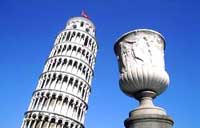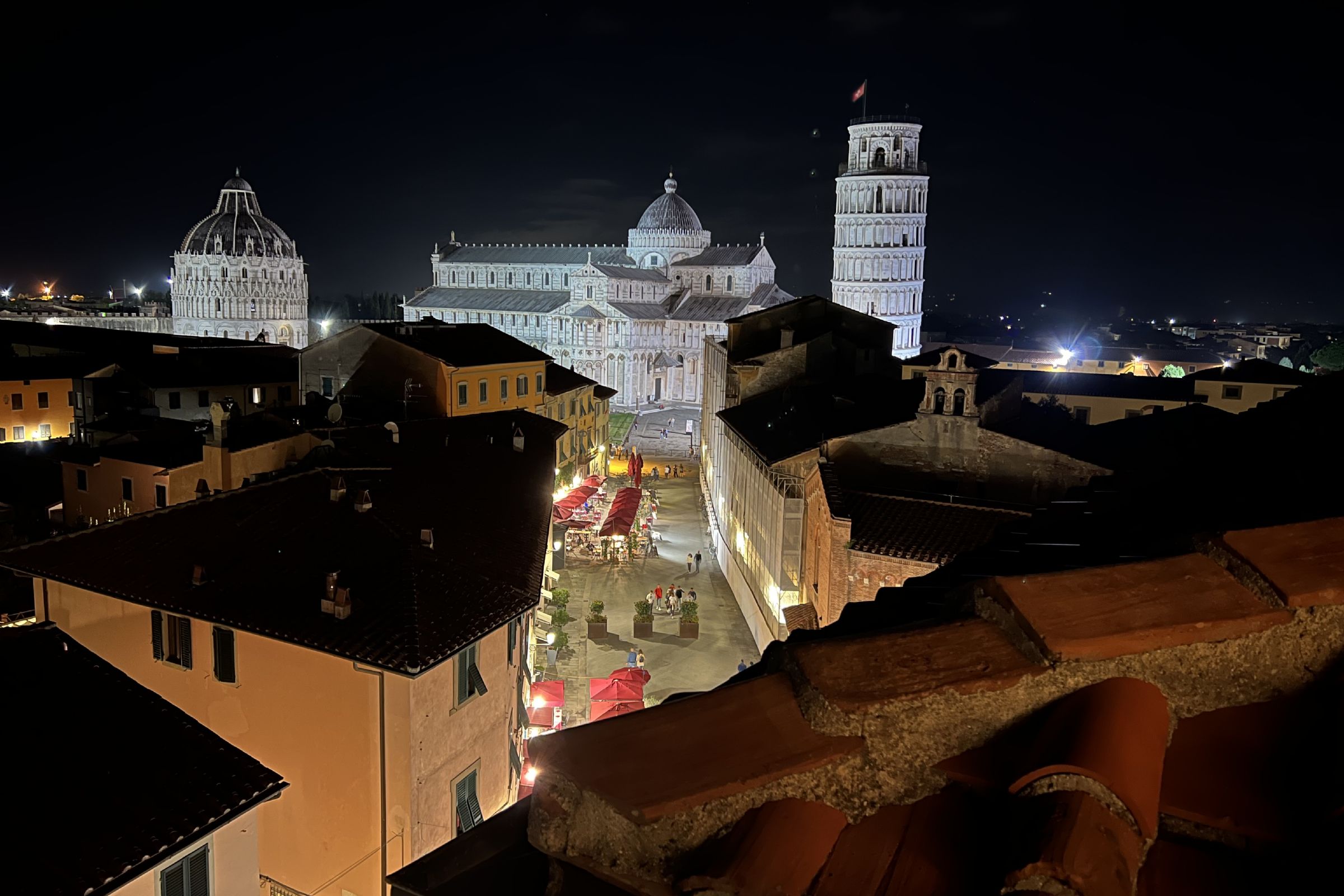In Holiday in Pisa visit ... The Square of Miracles!
In Holiday in Pisa, a must for all tourists is undoubtedly note the Piazza del Duomo.  Piazza del Duomo (known as Piazza dei Miracoli) meet at an area not very wide the impressive architectural monuments that make it famous around the world: the Cathedral, the Baptistery, the Leaning Tower and the Camposanto.
Piazza del Duomo (known as Piazza dei Miracoli) meet at an area not very wide the impressive architectural monuments that make it famous around the world: the Cathedral, the Baptistery, the Leaning Tower and the Camposanto.
Look at the ' photo album of the Square of Miracles in the Snow or that of the classic photos of Piazza dei Miracoli .
The visit is made even more enjoyable by the fact that the square is a pedestrian zone and you can admire its beauty in peace.
The square is also characterized by a portion of grass that helps to give a magical atmosphere.
The walls that surround the square were built to protect the religious center of the city. The construction work was begun in 1155 under the Coconut Griffi consulate and ended after about two centuries.
The Cathedral of Pisa
The Cathedral is the medieval cathedral of Pisa, whose construction was begun in 1063 - 1064 by architect Buscheto and consecrated in 1118 by Pope Gelasius II.
The facade is of gray marble and white decorations and presents with inserts of colored marble, while the front door is solid bronze.
The interior is made with black and white marble and has a coffered ceiling gilded seventeenth-century, in gilded and painted wood.
Inside are a series of paintings and sculptures in marble and bronze.
The Baptistery
The Baptistery, designed by Diotisalvi in 1152, was completed in the next century by Nicola Pisano. It presents a circular, decorated with blind arcades, cusps pierced, sculptures and mullioned windows.
The four-door, placed at the cardinal points, contribute to give to this particular structure. Note the door facing east for the presence of stylistic elements of the Byzantine nature.
Inside it contains important works such as the baptismal font (1246) made by Guido Bigarelli, the statue of St. John the Baptist (1926), the work of Italo Griselli and Pergamon (1260) by Nicola Pisano.
The Tower of Pisa
 The tower of Pisa, the symbol par excellence of the city, was conceived as a bell tower and is certainly one of the most famous Italian monuments in the world, characterized by the unmistakable elegance of its architectural structure as well as for its particular slope.
The tower of Pisa, the symbol par excellence of the city, was conceived as a bell tower and is certainly one of the most famous Italian monuments in the world, characterized by the unmistakable elegance of its architectural structure as well as for its particular slope.
Construction work began in 1174 as a bell attached to the Duomo and Baptistery, two magnificent buildings begun respectively in 1064 and in 1152.
During some excavations in the nineteenth century to the base of the tower he was found with an urn engraved above the name of Bonanno, who is credited with the design. Scholars have in fact attributed to the Bonanno figure of the famous sculptor Pisano author of the bronze doors of the Cathedral of Pisa and the door of the Cathedral of Monreale.
After a few years of existence, they experience the first settlements of the soil, causing the inclination of the tower on the side opposite to the current interruption and the relentless work of roughly half of the third floor.
Because of land subsidence, which caused a severe slope of the structure, the "Leaning Tower" became famous throughout the world.
Curiosity
THE DEVIL claws: on the north side of the Cathedral, or in front of the Monumental Cemetery, is a piece of marble Roman origin on which there are a number of little holes.
According to the legend of the signs would be left by the Devil when you climbed the Cathedral in a bid to halt the construction, why they are called "Devil's claw".
Again according to legend the number of these scratches would vary spite each time you try to count them (there are about 150, with some signs lighter for this sometimes overlooked in the counts). Visitors had fun counting them have failed to obtain the same number consecutively.THE LUCK OF PISA: the entrance door of the cathedral has numerous decorations in relief between which there is a small lizard that traditionally brings good luck to anyone who touches it, why is rubbed by many visitors and many students for the exams go well.
A COPY OF THE TOWER: there is another building similar to the famous Leaning Tower: the bell tower of St. Nicholas Church, one of the most important architectural works of the Middle Ages that is in Via Santa Maria.
To correct this defect of the stones were placed particular, following which the tower leaned to the side we know now.
The building is taken up by Giovanni di Simone only in 1275 and completed in the second half of the fourteenth century.
The tower of Pisa is one of the first monuments (with the Baptistery) which is repeated year after the architectural language used in the Cathedral. The tower is in fact spread over a circular plan and once again the theme of the open loggias with arches on columns, one of the reasons Romanico Pisans more successful.
In 2001, after eleven years of recovery that have decreased the slope of no less than 40cm, the tower of Pisa has been reopened to the public. The guided tour of the tower (40 min.) Takes you up to the loggia Campanara through a spiral staircase of 294 steps, consisting of a tilt of 5 degrees. Do not miss the opportunity to visit one of the most famous monuments in the world.
The Monumental Cemetery of Pisa
The Monumental Cemetery (1277), was born as a tomb for the members of the illustrious families of Pisa and citizens emeriti.
It has an external structure consists of simple white marble, and inside looks like a cloister, with arched ogive especially decorated.
He retained an extraordinary cycle of frescoes of the XIV and XV century (Taddeo Gaddi, Andrea Bonaiuti, the Master of the Triumph of Death, Benozzo Gozzoli), who have suffered severe damage during the Second World War. Also there are 84 sarcophagi preserved many ancient and medieval monuments funeral.
Plan Your Visit
To visit the monuments you can get information and buy tickets at the ticket office located in the Plaza or by contacting the Opera Primatial Pisana.
The ticket office for the Field of Miracles is next to the tourist office. We recommend the purchase of a ticket for the cathedral, the baptistery, the cemetery, the Museum dell'Operadel cathedral and the Museum of sinopie (about € 10.50). Alternatively tickets are available individual to visit the monuments. From November to March the entrance to the cathedral is free. To visit the tower of Pisa the ticket is separate, but expect long queues.
For info and reservations:
Tel. 050/38 72 211 or 050/38 72 212
E-mail: info@opapisa.it
Website: www.opapisa.it
MUSEUMS OF THE PIAZZA
Sinopia Museum: located in front of the Monumental Cemetery, on the opposite side of the square, it was built by Giovanni di Simone in 1258. The museum is in some circles thirteenth century Hospital of Santa Chiara, which displays the preparatory drawings (preparatory drawings of frescoes of Camposanto) authors of the fourteenth and fifteenth century, found during the restoration of the frescoes of the ancient cemetery.
Among the artists, Buffalmacco, Andrea Bonaiuti, Antonio Veneziano, Spinello Aretino, Taddeo Gaddi, Piero di Puccio, Benozzo Gozzoli and others.
MUSEUM OF THE WORK OF THE CATHEDRAL: in the ancient Palace of the Canons, was set up in 1986 and exhibits remarkable works of different eras from the four monuments of the Square of Miracles.
Many works belong to Giovanni Pisano, Tino of other Camainoe Nino Pisano.
